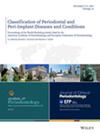Efficacy of horizontal platelet‐rich fibrin on gingival tissue regeneration: Cellular and histological analysis
IF 3.8
2区 医学
Q1 DENTISTRY, ORAL SURGERY & MEDICINE
引用次数: 0
Abstract
BackgroundHorizontal platelet‐rich fibrin (H‐PRF) is a novel platelet concentrate known for promoting tissue regeneration, the purpose of this study was to assess the impact of H‐PRF on gingival defects healing using both in vitro and in vivo approaches.MethodsHuman gingival fibroblasts (hGFs) were cultured with lipopolysaccharide (LPS), H‐PRF, and H‐PRF + LPS. Then, cell viability, proliferation, apoptosis and migration were evaluated via fluorescence staining, CCK‐8, flow cytometry, scratch and Transwell assays, respectively. Gingival defects were created in a rabbit model and treated with or without H‐PRF membranes. Tissue remodeling was evaluated at 14 and 21 days post‐surgery using hematoxylin and eosin (H&E) staining, Masson's trichrome staining, and immunohistochemistry (IHC) for E‐cadherin, and neovascularization was evaluated by IHC for CD31.ResultsH‐PRF promoted hGFs proliferation and migration and mitigated the negative effects of LPS on hGF viability and apoptosis. In animal model, H‐PRF significantly accelerated gingival defect closure, reduced pseudomembrane formation, and promoted the formation of a thicker, stratified squamous epithelium with rete peg formation by day 21. Compared with untreated defects, H‐PRF‐treated defects exhibited significantly increased collagen deposition and elevated expression of E‐cadherin. Moreover, enhanced neovascularization was observed in the H‐PRF group, as evidenced by the increased expression of CD31‐positive cells.ConclusionH‐PRF significantly improved gingival defects healing by enhancing hGF cellular behaviors and promoting epithelialization and neovascularization. These findings support the potential of H‐PRF as an effective adjunctive therapy during gingival tissue regeneration.Plain Language SummaryHorizontal platelet‐rich fibrin (H‐PRF) is a platelet concentrate derived from patient's own blood that has gained momentum in regenerative medicine due to its ability to support tissue repair. In our study, we compared the healing process of gingival defects treated with H‐PRF to those that healed naturally and found that the defects treated with H‐PRF healed more quickly and more completely. The treated areas contained stronger and more organized tissue, with improved blood flow. H‐PRF also helps the cells in the gums move to the injury site more effectively, which is important for faster and more complete healing. Our findings suggest that H‐PRF could be a useful tool to enhance the outcomes of soft tissue augmentation around natural teeth or implants, which would lead to healthier and stronger gingiva for patients.水平富血小板纤维蛋白对牙龈组织再生的作用:细胞和组织学分析
水平富血小板纤维蛋白(H - PRF)是一种新型血小板浓缩物,以促进组织再生而闻名,本研究的目的是通过体外和体内两种方法评估H - PRF对牙龈缺损愈合的影响。方法采用脂多糖(LPS)、H - PRF和H - PRF + LPS培养人牙龈成纤维细胞(hGFs)。然后,分别通过荧光染色、CCK‐8、流式细胞术、划痕和Transwell测定细胞活力、增殖、凋亡和迁移。在兔模型中创建牙龈缺损,并使用或不使用H - PRF膜治疗。术后14天和21天,用苏木精和伊红(H&;E)染色、马松三色染色和免疫组化(IHC)检测E -钙粘蛋白,用免疫组化(IHC)检测CD31评估新生血管。结果sh‐PRF促进hGF增殖和迁移,减轻LPS对hGF活力和凋亡的负面影响。在动物模型中,H‐PRF显著加速牙龈缺损的闭合,减少假膜的形成,并在第21天促进更厚、分层的鳞状上皮的形成,并形成网状钉。与未处理的缺陷相比,H - PRF处理的缺陷显示出明显增加的胶原沉积和升高的E -钙粘蛋白表达。此外,在H - PRF组中,CD31阳性细胞的表达增加,证实了新生血管的增强。结论h‐PRF通过增强hGF细胞行为、促进上皮化和新生血管形成,显著促进牙龈缺损愈合。这些发现支持了H - PRF作为牙龈组织再生过程中有效辅助治疗的潜力。水平富血小板纤维蛋白(H - PRF)是从患者自身血液中提取的血小板浓缩物,由于其支持组织修复的能力,在再生医学中获得了发展势头。在我们的研究中,我们比较了H - PRF治疗的牙龈缺损与自然愈合的牙龈缺损的愈合过程,发现H - PRF治疗的牙龈缺损愈合得更快、更彻底。治疗区域含有更强、更有组织的组织,血液流动也有所改善。H - PRF还有助于牙龈细胞更有效地移动到损伤部位,这对于更快、更完全的愈合非常重要。我们的研究结果表明,H - PRF可能是一种有用的工具,可以提高天然牙齿或种植体周围软组织的增强效果,从而使患者的牙龈更健康、更强壮。
本文章由计算机程序翻译,如有差异,请以英文原文为准。
求助全文
约1分钟内获得全文
求助全文
来源期刊

Journal of periodontology
医学-牙科与口腔外科
CiteScore
9.10
自引率
7.00%
发文量
290
审稿时长
3-8 weeks
期刊介绍:
The Journal of Periodontology publishes articles relevant to the science and practice of periodontics and related areas.
 求助内容:
求助内容: 应助结果提醒方式:
应助结果提醒方式:


